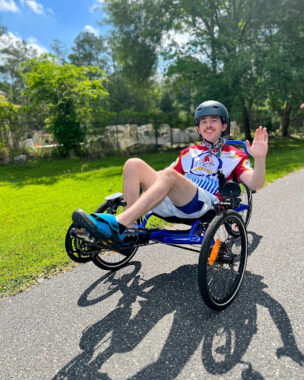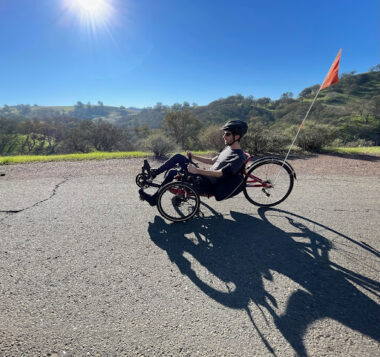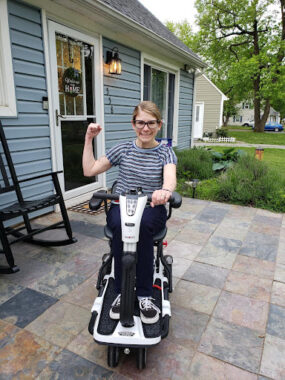The search for answers: My FA diagnosis story

Lauren Steffens/Unsplash
Nothing is scarier than the unknown. And for a rare progressive disease like Friedreich’s ataxia (FA), it can take years of dealing with the unknown until a diagnosis is confirmed through genetic testing, and each patient’s journey is different. Here is how four people with Friedreich’s ataxia struggled to get a diagnosis for their body’s sudden refusal to listen to them and what it felt like to finally, as one patient puts it, “put a name to the condition that had been haunting me for years.” These are their stories told in their words.
Noah Griffith’s story
“Only one thing was clear — things were getting worse.”
Noah Griffith, 22, lives in Salem, Alabama, and was diagnosed with FA in 2018 at age 16.

Noah at Ride Ataxia Gainesville (Photo courtesy of Noah Griffith)
All eyes in the classroom are on me. It’s the first day of 10th grade and my turn to introduce myself. My heart is pounding, and my throat opens just enough to force out some cloudy, scratchy-sounding words. I mutter my name and tell the class that I am sick. It was the only explanation I could give.
Not until midway through my junior year of high school did I hear the words that made sense of it all: Friedreich’s ataxia.
As time marched on, problems that I had no answers for continued to build — vocal issues were only the beginning. It took all my brain power in math class just to walk to the front of the room to turn in my homework without tripping over a bookbag or knocking into someone. I had no explanation for why the bar slanted and shook as I pushed it off my chest on the bench press, or why I ran like I was wearing ankle weights at baseball practice.
But my guess was as good as those of my local physical therapists, pediatricians, cardiologists, and neurologists. After two years of waiting for one uninformative doctor’s appointment after another, only one thing was clear — things were getting worse.
I was referred to a neurologist at the University of Alabama at Birmingham. After several more months waiting for the appointment, I was given a brief set of questions and assessments and the neurologist uttered the words “Friedreich’s ataxia.”
I had no idea what those words meant. My mom did some research and consulted my dad before explaining it to me. And from that moment, I knew it matched perfectly what I was experiencing. Genetic testing confirmed it three months later.
Learning I had a permanent, debilitating disease was heartbreaking, but having a diagnosis was a relief. It gave me the answers I needed to move forward and discover a true direction for my life.
Although I am uplifted by today’s advancements in FA research, I am hopeful that in the future people will be able to receive a diagnosis earlier in order to prevent the period of confusion when onset occurs.
 Find an FA specialist near you
Find an FA specialist near you
Frankie Perazzola's story
“It didn’t really seem like anything serious.”
Frankie Perazzola, 31, lives in Los Angeles and was diagnosed with FA in 2015 at age 22.

Frankie before a virtual training session (Photo courtesy of Frankie Perazzola)
I was always clumsy growing up but didn't think much of it. I just thought I was like any normal child and teen.
During high school and college, clumsiness was more prevalent. I was also drinking a lot of alcohol at the time, so I wasn’t really able to sense something was wrong. In college, I lived on the fifth floor of my dormitory and noticed I was white knuckling the railing on the stairs, my knees weren’t bending when I needed them to, and I was increasingly getting more tired when doing tasks that were once easy.
It took a few years to get the genetic testing done because of the rareness of FA. All of my bloodwork and other tests were coming back “normal,” so for a while, it was confusing for my doctors and myself. Because in order to find something like FA, you had to order a very specific test.
When my diagnosis was initially confirmed, no one around me (including myself) knew what was to come from having a progressive disorder. At the time, I was still walking around, so it didn’t really seem like anything serious. Fast forward eight years later and wow! — things have definitely changed.
Now I use a wheelchair full time and am constantly fatigued. I physically declined a lot during the pandemic from not being able to regularly go to the gym and drive. This led me on my current path of becoming a certified personal trainer and learning in-depth about the human body.
I was able to apply what I learned to my own way of moving my body and to helping others. From being able to properly train my grandma, to training others with disabilities on Zoom, to figuring out methods that worked for disorders like mine, I fell in love with it.
Currently, I am a personal trainer at a gym in Los Angeles. While I'm not sure how much longer I can contribute physically, I am enjoying that I can do it for now. My speech is slurred and I move awkwardly, but I have figured out ways to adapt and do my job of helping others. FA is horrendous, and I wish it never existed, but I’m figuring it out. You can too!
Sean Sommerville's story
“No normal person should be struggling so much to walk.”
Sean Sommerville, 24, lives in St. Louis, Missouri, and was diagnosed with FA in 2019 at age 20.

Sean on his recumbent trike at the summit — 3,750 feet elevation — of Mount Diablo in California (Photo courtesy of Sean Sommerville)
I remember walking down the hallway in high school and feeling unsteady. My balance was off, but I didn’t know why. I had stopped playing sports a couple of years before and figured it was because I wasn't getting enough exercise.
At the time, I was doing flight training to get my private pilot’s license and I didn’t want to see a doctor for fear of losing my medical certificate. It was difficult psychologically to have to concentrate when walking and constantly fearing stumbling and having to justify my imbalance. I had no explanation as to what was happening to me, which was a difficult thing to live with.
After I completed my freshman year at college, I decided I‘d had enough. It required immense concentration to walk and, even so, I was still unbalanced and wobbly. I knew no normal person should be struggling so much to walk.
I went to see a neurologist, who wasn’t sure what was wrong but suspected it was some sort of neuropathy. So I was transferred to a neuropathy specialist at the University of California San Francisco.
At first, they thought it was autoimmune neuropathy, which was splendid news as that could be treated. However, after running tests on my brother, they suspected genetic neuropathy. The sudden change in diagnosis was devastating. My goal was to be a professional pilot, but becoming a pilot and having an incurable neurological disease don’t typically go together.
Without a positive diagnosis, I was clinging to the hope that they were wrong and it was something treatable. After about a year and more tests than I can even remember, I was told I had Friedreich's ataxia. I didn’t know what that was.
I learned from a quick Google search that it was so much worse than I could have ever imagined. I went from having my dream career planned out to not even knowing what I was going to do with my life or how long I was going to live. While I could finally put a name to the condition that had been haunting me for years, I struggled to come to terms with the life I had ahead of me.
It took months before I could find the courage to try and do something with my life, but it hasn’t been easy. As time passes, everyday tasks become more and more difficult. The mental toll of the disease is immense — watching your independence slowly slip away and increasingly being limited in what you can do is hard.
While Friedreich’s ataxia still gets the better of me sometimes, I am proud of what I have accomplished in my education, career, and on my recumbent trike rides.
Christina Cordaro's story
“I was sad that things kept happening to my body.”
Christina Cordaro, 32, lives in Morrisville, Pennsylvania, and was diagnosed with FA in 2012 at age 21.

Christina shows her support for FA Awareness Day's Lend Us Some Muscle Campaign (Photo courtesy of Christina Cordaro)
I started noticing something was medically wrong when I was 17 years old. But I wasn’t diagnosed with FA until I was 21. The end of high school and college days were definitely affected in numerous ways.
The reason why my diagnosis journey took as long as it did was because I was five hours away for college. (I am from Bucks County, Pennsylvania — a suburb of Philadelphia — and still live there.) I would go to my doctor's appointments whenever I was home on holiday breaks. Because FA is so rare, the doctors and specialists could not pinpoint what I had and would refer me to get a second opinion elsewhere. This delayed the process that much more.
I was frustrated and angry simultaneously due to being in this "waiting game" and not knowing what was wrong with me. I was also sad that things kept happening to my body that I could not explain and were out of my control.
I went to four different hospitals before I was finally diagnosed genetically with blood tests at the Johns Hopkins Ataxia Center in Baltimore, Maryland. I was relieved when it was confirmed because I now knew what steps I needed to take to get the proper care.
I am now a patient at Children's Hospital of Philadelphia (CHOP)’s Friedreich's Ataxia Center of Excellence. The team is amazing, and I feel very fortunate and lucky. They give it their all and work endlessly to find a treatment and/or cure.
Since my diagnosis, I have become very active in the FA community. I am a Friedreich's Ataxia Research Alliance (FARA) Ambassador, I've participated in multiple clinical trials and clinical studies, and I have attended and hosted my family's own grassroots events, other members' grassroot events, and nationwide FA-based events. I am a strong advocate when it comes to raising awareness and funds for FA research.
Together we will cure FA!
Friedreich’s Ataxia News is strictly a news and information website about the disease. It does not provide medical advice, diagnosis, or treatment. This content is not intended to be a substitute for professional medical advice, diagnosis, or treatment. Always seek the advice of your physician or other qualified health provider with any questions you may have regarding a medical condition. Never disregard professional medical advice or delay in seeking it because of something you have read on this website.
Recent Posts
Related articles





